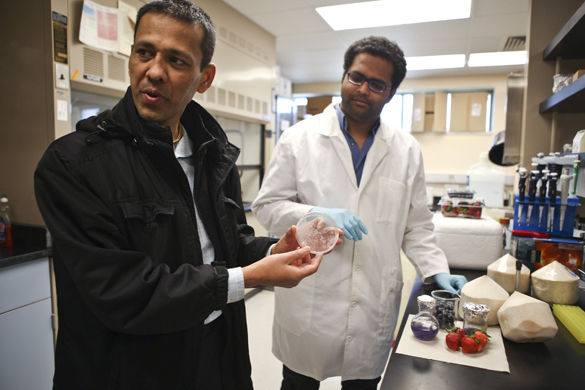SIU researchers discover potential alternatives to carcinogenic preservatives

January 25, 2016
Turmeric, a bright yellow spice native to India, has the capability of adding more than just an aromatic flavor to the plate, according to a team of SIU researchers.
Ruplal Choudhary, an associate professor in plant, soil and agriculture systems, is lead principle investigator of a team researching the potential health benefits of turmeric, which contains the natural antioxidant and anti-inflammatory agent curcumin.
Choudhary said this research is important because turmeric can be used as a natural way to delay the expiration date of foods. He said there is a growing concern that artificial food preservatives link to cancer, and shoppers should be able to identify ingredients on food labels.
Advertisement
“It has been scientifically proven that many synthetic preservatives are carcinogens,” Choudhary said. “Health-conscious people are going for natural products.”
Choudary worked with fellow principle investigators Derek Fisher, an assistant microbiology professor, and Punit Kohli, an assistant chemistry and biochemistry professor.
The group received $5,200 earlier this month from the deans of agriculture, science and engineering and $92,000 from the U.S. Department of Agriculture to fund research.
Their previous research beginning in 2011 — supported by a $400,000 grant from the Binational Agricultural Research and Development Fund based in Israel — revealed the spice also has antimicrobial qualities. It is powerful enough to potentially prevent E. coli outbreaks in food and lengthen the shelf-life of fresh produce, Choudhary said.
Jim Thomson, a second-year graduate student in plant, soil and agricultural systems from India, has been helping with the research as part of his thesis project.
Choudary said Thomson had the idea of testing the benefits further by combining limonene, a natural chemical found in citrus peels, with curcumin to produce an antibacterial and antifungal agent.
“He is getting good, encouraging results,” he said.
Advertisement*
Thomson said this coating, which damages E. coli cells and slows fungal growth, can be poured on berries and increase their shelf-life by three to four weeks.
They are also testing the use of Ultraviolet light, which damages E. coli cells, for use by small-scale farmers to store produce, Choudhary said.
“Basically, we are developing a UV-light purified cooler,” he said.
The team will present its research at the American Society for Agricultural and Biological Engineers this summer in Florida.
Anna Spoerre can be reached at [email protected] or 618-536-3325.
Advertisement








